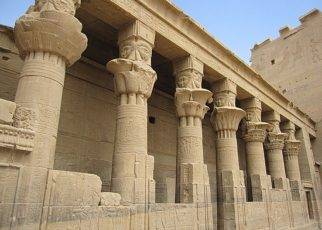Passing the Hall of Nectanebo from the boat landing en route to the main complex, one passes through the east and west colonnades of the outer court into an inner court, which is bookended by massive pylons covered in reliefs of Isis and Horus, as well as Ptolemy XII Neos Dionysos slashing his enemies.
Located in this central court is the mammisi or birth house, which is a small chapel, dedicated to Horus, where the god Horus is said to have been born and raised. The pharaoh would celebrate the birth of the god and partake in rituals as a means of ensuring his ascendency.
The gateway through the second pylon leads to a large hypostyle hall with ten decorative columns. Beyond the hall are three antechambers with rooms set off them, then the inner sanctuary, which consists of a small chamber with two tiny windows. Inside remains the pedestal where a gold statue of the goddess Isis would have once stood, housed in a granite shrine which now sits in the British Museum. Throughout all the rooms of the temple, the walls are covered by magnificent reliefs in a remarkable state of preservation.
East of the temple of Isis, sits a small but delightful temple dedicated to Hathor, the Egyptian goddess of love, music, and dance. The temple is decorated with beautiful reliefs of musicians playing for the gods.
There are a number of other gateways and temples housed on the island, built during the roman period, including the Temple of Augustus, the Gate of Diocletian, and the Kiosk of Trajan.





